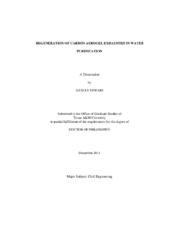| dc.description.abstract | Carbon has been used electrochemically in various forms for water treatment and the carbon aerogel is one of them. Carbon Aerogels (CA) are used as electrodes due to their high surface capacity and high electrical conductivity. They are also known as Carbon Nanofoams (CNF). CA electrodes attract oppositely charged ions that are nearby. This concept is known as Capacitive De-Ionization (CDI). The use of CA in CDI for water purification is well documented, but not much work has been done on regeneration of CA electrodes. Once saturated, these electrodes lose their ability to adsorb additional ions and it must be restored by regeneration. If they cannot be regenerated, they would need to be replaced, which would greatly increase the cost of the treatment they are expensive. The goal of this study is to obtain data to define optimal regeneration conditions and to develop predictive capability by examining desorption behavior of adsorbed ions on CA electrodes.
This study focuses on desorption of adsorbed ions and regeneration of CA. Various experiments were conducted to explore the effects on regeneration of CA of shorting of electrodes, change of polarity of electrodes, flow speed of water over CA electrodes, and temperature of regeneration water. The optimal combination of experimental variables was identified and was used for remaining experiments that tested the effect of size, charge and mass of adsorbed ions on regeneration of CA. Also, the effect of thickness of CA and its pore size on regeneration of CA was studied.
Results indicated that application of reverse potential for the first few minutes of the total regeneration time provided the greatest regeneration. Longer application of reverse potential did not result in higher regeneration. The regeneration behavior when no potential applied with and without shorting was as expected. Application of reverse potential with variable temperature or variable flow speed of water over CA surfaces provided results that were different from the ones that were obtained with no potential being applied with or without shorting of electrodes. | en |


